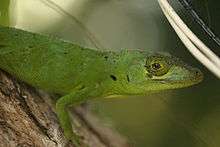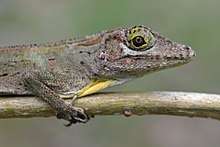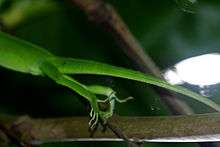Anolis cuvieri
Anolis cuvieri (Vernacular Spanish: lagarto verde,[4][5] lagarto chipojo;[6] Vernacular English: Puerto Rican giant anole,[4][5][7] Cuvier's anole,[4][8] green giant anole.[4]) is a species of lizard in the family Dactyloidae. The species is endemic to Puerto Rico,[9] and is common in the Toro Negro State Forest.[10]
| Anolis cuvieri | |
|---|---|
 | |
| Scientific classification | |
| Kingdom: | Animalia |
| Phylum: | Chordata |
| Class: | Reptilia |
| Order: | Squamata |
| Suborder: | Iguania |
| Family: | Dactyloidae |
| Genus: | Anolis |
| Species: | A. cuvieri |
| Binomial name | |
| Anolis cuvieri | |
| Synonyms[3][4] | |
Etymology
The specific name, cuvieri, is in honor of French naturalist Georges Cuvier.[11]
Description
Anolis cuvieri is a relatively large (for an anole) lizard with a mean snout–vent length (SVL) of up to 132 mm (5.2 in). It has a large, robust skull and long hind legs, as well as a serrated ridge of raised scales along its back. Like most anoles, this species has large flattened disks under the second and third phalanges of each toe which enable it to adhere to vertical surfaces. This species is predominantly green in body coloration with some individuals displaying faint light green stripes on the sides and dorsal surface.
In some animals, particularly large adult males, the head is heavily blotched with sky blue coloration which suffuses onto the nape. This coloration may extend onto the neck area or even onto the dorsal surface running the length of the spine. In females where the blue coloration is present it is only as a sky blue tint on the head which does not extend onto the neck.

In both males and females the orbital area is either bright yellow or vibrant yellow-green. Both male and female Puerto Rican giant anoles possess a large dewlap; however, it is noticeably larger and colored bright yellow in males whereas in females it is light green with a blue green superior portion and faint black stripes running horizontally across the upper two thirds. The coloration of Anolis cuvieri is ontogenic, with juveniles of both sexes being gray brown or brown in color with brown vertical stripes running along the entire dorsal surface of the body as well as the limbs. As they mature, juveniles gradually acquire the green adult coloration. There also exists a rare brown adult morph of A. cuvieri which is solid brown in body coloration with black spots on the sides and neck and a yellow blotched orbital area. Both sexes possess a large erectile crest on the tail, though it is usually higher in males.
Habitat
Anolis cuvieri belongs to a group of anoles known as crown giants, these are large species which inhabit the uppermost canopy of tall trees and rarely descend to ground level. Anolis cuvieri is only found in intact forest regions where large quantities of large trees are present. They are typically active several meters above the ground and are found mainly in palm, Ficus, and other large trees. This species locomotes by jumping from branch to branch within the canopy, a lifestyle for which it has evolved long hind limbs. It is a mesic species, preferring areas of wet forest over more xeric conditions, where it is rarely found.
Diet
Like all anoles, Anolis cuvieri is primarily insectivorous, feeding on arboreal insects such as large beetles and lepidopterans. This species is also an opportunist species, and its robust skull and powerful bite allow it to take a wide range of prey including other anoles, juveniles of its own species and small birds as well as large snails and occasionally fruit.
Behaviour
Both sexes of Anolis cuvieri are extremely territorial and aggressive. Males, however, are particularly aggressive not only towards other males but also towards any organism or object that the anole perceives to be a threat. Males that encounter intruders in their territory will generally perform elaborate bodily displays, extending and recoiling the dewlap and performing various head bobs or pushups. This is usually done well before the intruder manages to get within close proximity of the defender and the display is often successful at warding off the intruder. However, if the intruding male is persistent then a fight may ensue with the males locking jaws and biting at each other's extremities until either male either gives up and flees or dies of exhaustion. Fights may also prove fatal if a serious wound, such as an amputated limb, occurs and subsequently becomes infected. This species attempts to bite when handled and its powerful jaws are capable of breaking skin. It may also display at a potential predator or captor if one is sighted. Like many reptiles the mouth of this species harbors Salmonella and an infection may occur if a bite breaks the skin.
Threat and conservation
Anolis cuvieri is currently under threat in Puerto Rico due to the effects of past deforestation and environmental degradation. It is now only found in a select few areas of intact natural forest but its population appears to be stable. During Puerto Rico's period of rampant deforestation in the early twentieth century this species disappeared almost entirely and was not sighted for many years. It was feared extinct until after the agricultural collapse in Puerto Rico (late 1950s) which resulted in an end to deforestation. After this, the species made a remarkable recovery and, though its distribution is still limited, it has become quite common in some of the remaining areas of natural rainforest on the island.
Gallery
 Anolis cuvieri consuming a beetle
Anolis cuvieri consuming a beetle Hind legs of Anolis cuvieri
Hind legs of Anolis cuvieri Rare brown morph Puerto Rican giant anole
Rare brown morph Puerto Rican giant anole Anolis cuvieri looking
Anolis cuvieri looking
See also
- List of amphibians and reptiles of Puerto Rico
- Fauna of Puerto Rico
- List of endemic fauna of Puerto Rico
References
- Anolis cuvieri - Classifications: Cuvier's Anole. Encyclopedia of Life. Retrieved 31 August 2013.
- Anolis cuvieri Merrem, 1820. Archived March 12, 2009, at the Wayback Machine ITIS (Integrated Taxonomic Information System). Taxonomic Serial No.: 173888. Retrieved 31 August 2013.
- Taxonomic Serial No.: 564554. ITIS. Retrieved 31 August 2013.
- Anolis cuvieri MERREM, 1820. The Reptile Database. (www.reptile-database.org) Retrieved 1 September 2013.
- Volume 1: Land Cover, Vertebrate Species Distributions, and Land Stewardship. William A. Gould, Caryl Alarcón, Brick Fevold, Michael E. Jiménez, Sebastián Martinuzzi, Gary Potts, Maya Quiñones, Mariano Solórzano, and Eduardo Ventosa. The Puerto Rico Gap Analysis Project. (Publication Number: IITF-GTR-39) USDA. Forest Service. International Institute of Tropical Forestry. March 2008. Page 86. Retrieved 18 August 2013.
- 2002 Wildlife Facts: Giant Anole. El Yunque National Forest. Retrieved 31 August 2013.
- Integrated Taxonomic Information System (ITIS)
- Anolis cuvieri - Names: 4 Common Names. Encyclopedia of Life. Retrieved 1 September 2013.
- Anolis cuvieri. Retrieved 31 August 2013.
- Bosques de Puerto Rico: Bosque Estatal de Toro Negro. Archived August 7, 2015, at the Wayback Machine Hojas de Nuestro Ambiente. July 2008. [Publication/Issue: P-030] Puerto Rico Department of Natural and Environmental Resources. Retrieved 31 August 2013.
- Beolens, Bo; Watkins, Michael; Grayson, Michael (2011). The Eponym Dictionary of Reptiles. Baltimore: Johns Hopkins University Press. xiii + 296 pp. ISBN 978-1-4214-0135-5. (Anolis cuvieri, p. 63).
Further reading
- Boulenger GA (1885). Catalogue of the Lizards in the British Museum (Natural History). Second Edition. Volume II. Iguanidæ ... London: Trustees of the British Museum (Natural History). (Taylor and Francis, printers). xiii + 497 pp. + Plates I-XXIV. (Anolis cuvieri, pp. 23–24).
- Merrem B (1820). Versuch eines Systems der Amphibien: Tentamen Systematis Amphibiorum. Marburg: J.C. Krieger. xv + 191 pp. + one plate. (Anolis cuvieri, new species, p. 45). (in German and Latin).
- Schwartz A, Thomas R (1975). A Check-list of West Indian Amphibians and Reptiles. Carnegie Museum of Natural History Special Publication No. 1. Pittsburgh, Pennsylvania: Carnegie Museum of Natural History. 216 pp. (Anolis cuvieri, p. 76).
External links
- Anolis cuvieri. Puerto Rico Gap Analysis.